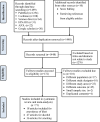Magnitude and risk factors of khat, alcohol and cigarettes use among pregnant women in Africa: a systematic review and meta-analysis
- PMID: 39604865
- PMCID: PMC11600575
- DOI: 10.1186/s12884-024-06999-7
Magnitude and risk factors of khat, alcohol and cigarettes use among pregnant women in Africa: a systematic review and meta-analysis
Abstract
Background: The use of khat, alcohol, and cigarettes during pregnancy is a serious public health problem associated with harmful outcomes for the fetus and the mother's health. Studies that investigated khat, alcohol, and cigarettes usage during pregnancy yielded varied and contradictory results. This study used a systematic review and meta-analysis to estimate the pooled prevalence and associated factors of khat, alcohol, and cigarettes use among pregnant women in Africa.
Methods: A review of eligible studies was conducted using Preferred Reporting Items for Systematic Reviews and Meta-Analysis (PRISMA) guidelines. This review has been registered in PROSPERO with protocol ID CRD42021289074. Literature published in English from January 1, 2002 to November 30, 2021 was retrieved from PubMed, Google Scholar, Cochrane, HINARI, African Journal Online, and Science Direct databases. The quality of included articles was assessed using the Joanna Briggs Institute's (JBI) critical appraisal checklist. The I2 statistic and Cochran's Q test were used to assess the presence of heterogeneity between studies. To assess publication bias, a funnel plot and Egger's regression test were utilized. The random effect model was used to estimate the summary prevalence and the corresponding 95% confidence interval (CI) of risk factors for khat, alcohol, and cigarettes use.
Results: Out of the 1509 studies identified, 71 met the inclusion criteria. The pooled prevalence of khat chewing, alcohol drinking, active smoking, and secondhand smoke exposure during pregnancy was 18.93%, 22.20%, 11.85%, and 43.45%, respectively. The subgroup analysis by UN sub-region showed the highest pooled prevalence of alcohol use during pregnancy in Middle Africa (25.69%) and the lowest in Northern Africa (1.10%). Several factors were identified as risk factors for alcohol use, including low educational level, younger age women, pre-pregnancy alcohol use, unplanned pregnancy, history of abortion, poor social support, mental distress, poor knowledge on alcohol risks, and partner alcohol use.
Conclusion: This review indicated that the pooled magnitude of khat, alcohol and cigarette use during pregnancy was higher in Africa. Substance use screening and brief interventions (SBI) should be routinely delivered in antenatal care settings to reduce pregnant women's substance use.
Keywords: Africa; Alcohol; Cigarette; Khat; Pregnancy; Systematic review and meta-analysis.
© 2024. The Author(s).
Conflict of interest statement
Declarations. Ethics approval and consent to participate: Not applicable. Consent for publication: Not applicable. Competing interests: The authors declare no competing interests.
Figures






Similar articles
-
The epidemiology of khat (catha edulis) chewing and alcohol consumption among pregnant women in Ethiopia: A systematic review and meta-analysis.PLOS Glob Public Health. 2023 Sep 15;3(9):e0002248. doi: 10.1371/journal.pgph.0002248. eCollection 2023. PLOS Glob Public Health. 2023. PMID: 37713384 Free PMC article.
-
Prevalence and associated factors of khat chewing among students in Ethiopia: a protocol for systematic review and meta-analysis.BMJ Open. 2018 Nov 25;8(11):e021157. doi: 10.1136/bmjopen-2017-021157. BMJ Open. 2018. PMID: 30478104 Free PMC article.
-
Alcohol consumption and its associated factors among pregnant women in Sub-Saharan Africa: a systematic review and meta-analysis' as given in the submission system.Subst Abuse Treat Prev Policy. 2020 Apr 15;15(1):29. doi: 10.1186/s13011-020-00269-3. Subst Abuse Treat Prev Policy. 2020. PMID: 32293479 Free PMC article.
-
Post-abortion family planning use and its determinants among women who received abortion care in sub-Saharan Africa: a systematic review and meta-analysis.Syst Rev. 2025 Jun 10;14(1):126. doi: 10.1186/s13643-025-02837-9. Syst Rev. 2025. PMID: 40495240 Free PMC article.
-
The prevalence and factors associated with alcohol use disorder among people living with HIV/AIDS in Africa: a systematic review and meta-analysis.Subst Abuse Treat Prev Policy. 2020 Aug 24;15(1):63. doi: 10.1186/s13011-020-00301-6. Subst Abuse Treat Prev Policy. 2020. PMID: 32831129 Free PMC article.
Cited by
-
Preconception health risks among women of reproductive age in Sub-Saharan Africa: a systematic review of implications for preconception care.J Health Popul Nutr. 2025 May 21;44(1):164. doi: 10.1186/s41043-025-00888-1. J Health Popul Nutr. 2025. PMID: 40399959 Free PMC article. Review.
References
-
- Popova S, Lange S, Probst C, Gmel G, Rehm J. Estimation of national, regional, and global prevalence of alcohol use during pregnancy and fetal alcohol syndrome: a systematic review and meta-analysis. Lancet Glob Health. 2017;5(3):e290–9. - PubMed
-
- Broccia M, Hansen BM, Winckler JM, Larsen T, Strandberg-Larsen K, Torp-Pedersen C, et al. Heavy prenatal alcohol exposure and obstetric and birth outcomes: a Danish nationwide cohort study from 1996 to 2018. Lancet Public Health. 2023;8(1):e28–35. - PubMed
Publication types
MeSH terms
LinkOut - more resources
Full Text Sources
Medical
Miscellaneous

